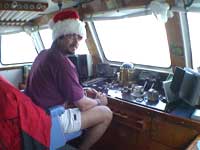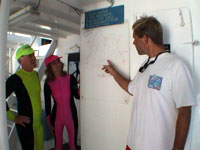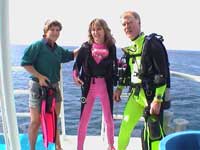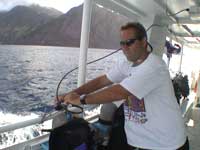
Today we begin our scuba diving on our expedition ship the Caribbean Explorer. Our captain, Jean -François, had planned for us to leave St. Maarten last night, but strong winds and 12-feet-high seas prevented us from departing until this morning. We left at 6:30 a.m. and arrived off the island of Saba at 9:30 a.m., a 26-mile trip. The Caribbean Explorer is designed especially for scuba diving expeditions. It’s made of aluminum and measures 107 feet long and 21 feet wide. It makes week-long expeditions exploring the islands of St. Maarten, Saba, St. Eustatius, and St. Kitts. With a crew of 7, it can take up to 18 divers. But we have only 9 divers on our expedition. With us is a couple from Switzerland, a man from England, a man from France and a father with his two sons from Salt Lake City, Utah. Every day, we will be making five scuba dives, with each dive lasting from 35 to 75 minutes. That totals to over six hours underwater each day! Our diving day starts at 8 a.m. when we hear a horn blow. Actually, the noise is not really a horn. It’s divemaster Steve blowing on an empty conch shell. (A divemaster is the person in charge of the diving.) The snail was removed and when he blows into the shell, it sounds like a trumpet! When the divers have gathered, divemaster Steve explains what our dive will be. He draws on a map on the dive board and explains where the ship is anchored, how deep the water is, where the reef is, and what we should look for on the reef. Divemaster Steve joins us on the dive to help find things to investigate underwater. He also helps if anyone has a problem while diving. To get ready to scuba dive we put on our diving equipment. Each diver wears:
Out of the water all of our equipment weighs about 50 pounds. But underwater we can adjust our buoyancy (floating and sinking) so we are weightless – like astronauts on a space walk. Once our dive is over, and before we can dive again, our air tanks must refilled. Our air tanks are made of aluminum and weigh about 35 pounds on land when full of air. But underwater air tanks are almost weightless. Divemaster Steve connects an air hose to our tanks and refills them by pumping air back into them from the ship’s large air pump, called an air compressor. (The process is kind of like pumping up a bicycle tire.) After our tanks are refilled, we’re ready for another dive! |
The Captain of the Caribbean Explorer is Jean -François, from Quebec, Canada.
Divemaster Steve draws a map on the dive board and points out to us what we should look for on the reef.
Wayne and Karen have on all their scuba diving equipment and are ready to jump into the water to start their dive. They are standing next to Jennifer, the ship’s manager.
After our dive, Divemaster Steve refills our air tanks with a long air hose from the ship’s air compressor. |
||||||||||||||||||
|
||||||



